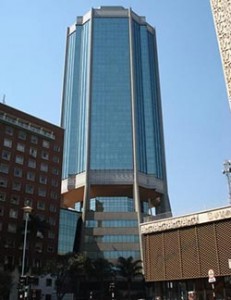 The Reserve Bank of Zimbabwe is precipitating commotion in the Zimbabwe’s economy as it continuously sing praise to bond notes that have ruined Zimbabwe’s economy since their introduction. The central bank introduced bond notes in November 2016 against the will of Zimbabweans who held various demonstrations and engagement meetings with the governor expressing the fear that the introduction would triggeeconomic disorder. Mangudya, however, hoodwinked Zimbabweans into believing that bond notes would only be used as an ex-port incentive and depositors would still access the currency of their choice with much ease.
The Reserve Bank of Zimbabwe is precipitating commotion in the Zimbabwe’s economy as it continuously sing praise to bond notes that have ruined Zimbabwe’s economy since their introduction. The central bank introduced bond notes in November 2016 against the will of Zimbabweans who held various demonstrations and engagement meetings with the governor expressing the fear that the introduction would triggeeconomic disorder. Mangudya, however, hoodwinked Zimbabweans into believing that bond notes would only be used as an ex-port incentive and depositors would still access the currency of their choice with much ease.
Instead of bringing the much promised relief and stability, the introduction of bond notes has only helped to fuel chaos as both business and consumers are in panic mode. The development has seen both informal and formal business responding with a three-tier pricing system were goods at-tract different prices for plastic money, bond notes and the United States dollar. The system favours those with cash while interest of between 30 and 40% is charged for plastic and mobile money transactions.
The resurrection of the parallel market has further exposed the misconception by the RBZ governor that the bond notes would trade at par with the United States dollar. The value of the bond note is not at par with that of the United States dollar, contrary to official assurances by the governor when they were introduced last year. Some have resorted to sleeping in queues as a means of ensuring that they get money from the bank. Not only are depositors failing to access currencies of their choice as espoused by the central bank governor, but are also spending long hours in bank queues only to get as little as US$20 in in denominations of 5, 10, 25 and 50 cent coins.
According to the Zimbabwe Coalition of Debt and Development (ZIMCODD) the unacceptability of bond notes compared to other currencies, (US$, Rand, Pound, Euro, etc), brought about the foreign currency black market.
The liquidity crisis introduced the use of plastic money to aid transactions but the public failed to totally accept plastic money as equivalent to hard cash. This brought about another form of black market, where the bond note was traded with electronic money (swipe and mobile money transfers);
These two parallel/black markets are currently holding money from the banking industry as money that ever gets out of the bank never finds its way back;
ZIMCODD postulates that the poor will continue to lose their hard earned money to the black market and further to that lack of confidence in the financial and political sector will lead to demonstrations and riots as the public map their way for the 2018 elections.
Post published in: Business

